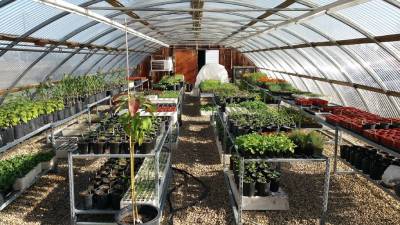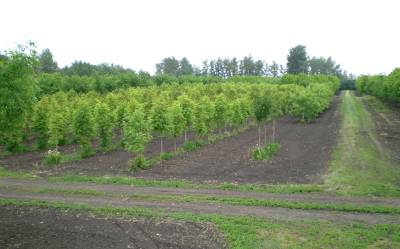The City hires a crew of contracted water trucks to water newly planted and transplanted City-owned trees for approximately three years to ensure growth and establishment.
The City of Edmonton is responsible for over 380,000 boulevard and open space trees that make up a large portion of our urban forest. Crews work behind the scenes to keep Edmonton’s tree canopy healthy, safe and sustainable.
After-Hour Tree Hazards
7pm-7am: Monday-Saturday, Sundays and statutory holidays.
For tree-related safety concerns such as broken branches and fallen trees that are an immediate hazard or an essential public safety concern.
Tree Replacement
To help maintain the size of Edmonton’s urban forest, the City replants boulevard and open space trees through the Tree Replacement Program. In even-numbered years, such as 2024, the west side of the city will be the primary focus for tree replacement and in odd-numbered years, the east side of the city will be the primary focus for tree replacement.
Tree Assessment
City of Edmonton trees that have died are assessed by the Urban Forestry Inventory and Assessment team and are then marked and scheduled for removal. Every year, trees in one-half of the city are assessed by this team. If a tree has been marked for removal, it will be replaced through the Tree Replacement Program, generally within two years.
Damaged Trees - Storm Cleanup
Storms and heavy winds can sometimes have a negative impact on our urban forest canopy, especially by breaking large branches of mature trees. The City quickly responds by organizing crews to work on impacted areas for a safe and efficient cleanup.
If a privately-owned tree falls onto City property, Urban Forestry will remove any debris and hazards from City property. Any brush or debris from the privately-owned tree will be left for the private property owner to remove from the site.
Care and Beautification Operations
Tree Watering
Tree Pruning
City-owned trees are pruned on a regular, cyclical schedule. Pruning promotes long-term tree health and structure and helps to eliminate potential hazards. Pruning operations follow the best management practices in terms of pruning techniques and cycles.
- Most boulevard and open space trees are pruned on a 5-year cycle, except for conifers and trees prone to specific diseases
- Trees prone to diseases such as Dothiorella elm wilt (Dothiorella ulmi) are pruned every 5 years, while trees with black knot (Apiosporina morbosa) and fire blight are pruned every 4 years
- Conifers are not pruned by the City, unless there are explicit safety concerns as identified by an Urban Forester
- Approximately 57,000 City-owned trees are scheduled for pruning annually, as per the operational work plan
- Urban Forestry does not provide clearance pruning for non-safety-related signage and businesses, as this is considered cosmetic
- If a City-owned tree is blocking a traffic light or traffic sign, please contact 311
Urban Forestry does not prune privately-owned trees for clearance purposes within rear alleyways. If the tree in the alleyway is City-owned and of concern, please call 311 for an evaluation.
The Federal Migratory Birds Convention Act, 1994 (MBCA) and Alberta Wildlife Act and their regulations protect migratory and resident birds. To comply with these regulations, pruning may be delayed if a nest is identified within a tree. Conducting work outside the breeding bird season is the best way to avoid disturbing or damaging nests; therefore, this work may be completed in the fall or winter.
As per the Community Standards Bylaw (14600), the pruning and removal of elm trees is only permitted between October 1 and March 31. If there is an immediate concern or request for elm tree pruning outside the regulated season, please contact Pest Management to be considered for an exemption permit.
Tree Lighting
As part of its beautification initiatives, the City of Edmonton strings over 2,000 trees with sparkling white lights. These trees are primarily located in the Business Improvement Areas of the City, with a few other installations at locations such as City Hall, Giovanni Cabotto and Ezio Faraone Parks.
These lights do far more than beautify our streets. They encourage residents to spend time outside at night, resulting in safer, more vibrant spaces. This beautification attracts evening customers and visitors to businesses in the area, which leads to economic gain.
The City lights its trees with low-wattage LED lights. A full-sized mature elm strung with lights uses less electricity than a conventional 60-watt light bulb. Photocells and timers are also used to reduce energy consumption during non-essential hours of the day.
Edmontonians can enjoy the glow throughout the season as these lights remain up year round.
The Urban Forestry team is currently reviewing the process for submitting tree lighting requests on City-owned trees.
The City of Edmonton has operated Old Man Creek Nursery since 1910. Currently, the nursery grows, receives, and cares for the trees, shrubs, and wildflowers that are planted by the City Operations department.
This effort supports the growth and health of our urban forest canopy by providing high-quality, disease-free plant material. Annually, the nursery receives, cares for and ships approximately 3,500 caliper trees, and 25,000 native plants.
At any given time, there are approximately 7,000 trees being grown in the nursery fields, some of which are trial species being tested for their suitability for Edmonton’s climate to increase the diversity of the urban forest and create a healthy and sustainable urban forest.
2024 Urban Forestry Team Highlights
- 7,413 Boulevard and open space trees planted
- 2 Grow Together community plantings and events
- 524 Caliper trees harvested from the Old Man Creek Nursery
- Processed over 800 Public Tree Permit applications
- 166,300 Boulevard and open space trees assessed
- Over 43,000 boulevard and open space trees pruned
- Over 60 educational sessions delivered




